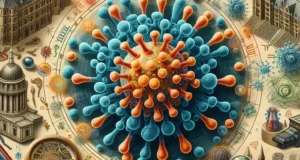Imagine trying to catch smoke with your bare hands—just when you think you’ve got it, it slips away, reshaping itself in midair. That’s what scientists are up against when dealing with HIV, a master of disguise. What gives this virus such an extraordinary ability to survive, spread, and evade? The answer lies in a powerful trick written into its very nature: viral mutation.

When people ask “AIDS – where did it come from?”, the story doesn’t stop at the forests of Africa or the first human infection. To truly understand HIV’s global impact, we must examine how it mutates—how it changes its genetic makeup to stay one step ahead of the immune system, treatments, and time itself.
But the enzyme it uses for this process, reverse transcriptase, is notoriously sloppy. Unlike human DNA copying machines, which check for typos, HIV’s machinery lets countless “mistakes” slip through. These so-called mistakes are what scientists call mutations—and they’re no accident. They’re part of HIV’s survival blueprint.
Each time HIV replicates, it slightly alters its genetic code, like a thief changing outfits after every robbery. This rapid mutation rate allows it to dodge immune responses and develop resistance to medications faster than most viruses we’ve ever known. It’s as if you’re fighting a new version of the virus every time you confront it.
So, AIDS – where did it come from?
It came from a virus born in the jungle, yes, but it spread and survived because of its mutating nature. After crossing over from chimpanzees (carrying SIV) into humans through bushmeat hunting or blood exposure, HIV didn’t stay still. It evolved—adapting to its new host, fine-tuning its attacks, and carving out its own path within human populations.
By the time HIV reached urban centers like Kinshasa during the colonial era, it was already a step ahead. It mutated to adapt to new hosts, new immune systems, and eventually, new continents. This silent, genetic evolution happened behind the scenes, while the world was still unaware of the storm brewing within.
That’s why when AIDS first emerged in the 1980s, doctors were stunned by the virus’s ability to morph and resist treatment. Unlike viruses that follow a predictable course, HIV became a moving target—always changing, always escaping.
This ability to mutate also means there isn’t just one HIV. There are multiple subtypes, or “clades,” scattered across different regions of the world. Each with slightly different genetic fingerprints, each shaped by the geography and people it infects. HIV’s mutational flexibility is what allowed it to become a global pandemic rather than a local outbreak.
So, when we reflect on the question “AIDS – where did it come from?”, we’re really asking how did a virus from the forest become one of the greatest challenges in modern medicine? The answer is: it mutated, it adapted, and it thrived.

But there’s hope. Understanding HIV’s mutational strategies has led to modern antiretroviral therapies (ART)—combinations of drugs that target different parts of the virus’s life cycle, making it harder for the virus to escape. We’ve learned to use HIV’s own complexity against it.
In the end, HIV isn’t just a virus. It’s a shapeshifter, a genetic chameleon that emerged from nature with a terrifying gift: the ability to change. But with science, strategy, and global effort, humanity continues to adapt as well.
So yes—AIDS, where did it come from?
It came from a virus that refuses to stand still. And it taught us that in the world of disease, the fight is not just against infection—but against evolution itself.




